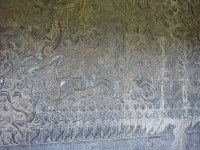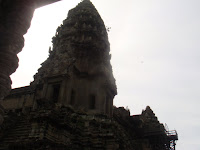"One of these temple - a rival to that of Solomon, and erected by some ancient Michelangelo - might take an honourable place beside our most beautiful buildings. It is grander than anything left to us by Greece or Rome, and presents a sad contrast to the state of barbarism in which the nation is now plunged."
Henri Mouhot (1826-1861),
on his remarks that popularise Angkor Wat to the West.
 Infront Angkor Wat
Infront Angkor Wat
Henri Mouhot (1826-1861),
on his remarks that popularise Angkor Wat to the West.
 Infront Angkor Wat
Infront Angkor WatOnly on my third day we went to the Angkor Wat. Well, you need to save the best at last. My mission to complete another tour to one of the Wonders of the World yet not achieved. After visit to Egypt to enjoy the Grand Pyramid of Giza in 2001, I've made another move to the remaining list. Eventhough Angkor Wat is not in the Ancient Wonders of World as compiled by Antipater of Sidon in Greek Anthology IX.58 around 140 BC; I blamed it to the Greek as he couldn't make trip to this side of the world. For those who have experienced it, Angkor Wat can be as majestic as others.
From left : one of the lion guardian of Angkor Wat, west gopura with 3 towers - the southern part contain statue of Vishnu
For Cambodian, Angkor Wat acted as source of national pride and one of big income for them. This temple has been part of their life hundred years back as evidence of this image in their national flag - dated back since 1863. And with 600,000 ++ tourist visited this place every year thus represented more than 50% of total Cambodian tourist, you can do the count on how much this will generate the local's economic growth. King Survayarman II would never imagine that Angkor Wat or Preah Pisnulok (the old name for Angkor Wat) - which once exclusively for the Kings and Palace Priest will be full of common people nowadays.
From left : bas-reliefs of Battle of Lanka from the epic Ramayana, clash between 2 cousins - Kauravas and Pandavas as being told in Mahabharata.
From left : King Yama on His water buffalo from Heaven & Hell gallery, Vishnu in the Churning of the Ocean of Milk - where devas and asuras tug on the serpent Vasuki to produce amrita (elixir of immortality).
From left : steps to the central sanctuary of Angkor Wat, Apsaras - one of the creation from Churning of the Ocean of Milk - others are three headed elephant; Airavana and the goddess of beauty; Lakshimi.
This temple was built around / circa 12th century - means "City Temple" dedicated to Vishnu and later Buddha. Its a great achievement for the Khmer temple architecture in terms of its size and resources used. It is designed to represent Mount Meru, home of the devas in Hindu mythology: within a moat and an outer wall plus three rectangular galleries, each raised above the next. At the centre of the temple stands a quincunx of towers. Unlike most Angkorian temples, Angkor Wat is oriented to the west; that scholars are still divided as to the significance of this. Some conclude that Suryavarman II intended it to serve as his funerary temple while others think its alignment was due to its dedication to Vishnu, who was associated with the west. What ever the reason - Angkor Wat has drawn praise above all for the harmony of its design, which has been compared to the architecture of ancient Greece or Rome.
From left : sandstones block as the main building material (good in absorbing water) and laterite from Phnom Kulen as outerwall, one of the Angkor Wat's tower.
From left : gallery of Thousand Buddha, Sanskrit inscriptions on one of the gallery's column.
Now, with thousands of visitor came to this site - Angkor Wat has been exposed with danger / damage made by human. Restoration and conservation works still ongoing and depends a lot on foreigners investment. But with this kind of project, I couldn't explore this site much as some are still closed including the central tower - WOW! another blow to me after the 1000 lingas of Phnom Kulen. And another thing - not much picture that I can upload through this blog.
Now, with thousands of visitor came to this site - Angkor Wat has been exposed with danger / damage made by human. Restoration and conservation works still ongoing and depends a lot on foreigners investment. But with this kind of project, I couldn't explore this site much as some are still closed including the central tower - WOW! another blow to me after the 1000 lingas of Phnom Kulen. And another thing - not much picture that I can upload through this blog.
From above left to right : both showed different scene of northwest tower, infront one of library in Angkor Wat, another scene of northwest tower - this time from the Echo Room, both pictures showed inside pools at the first level of the temple.
























No comments:
Post a Comment